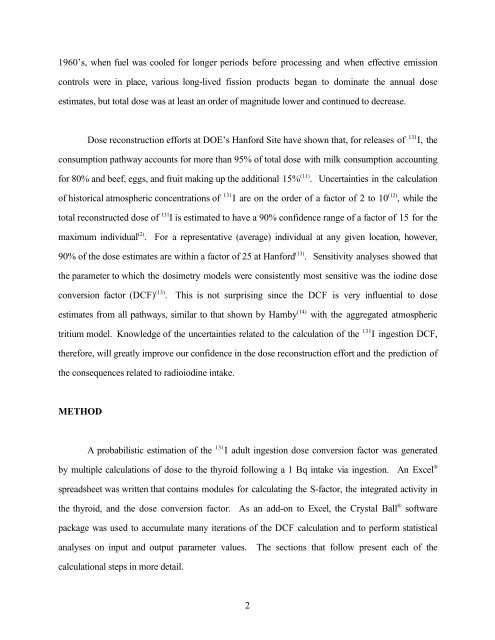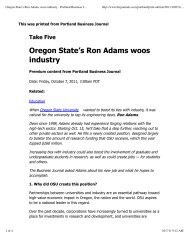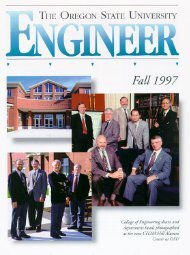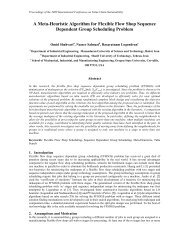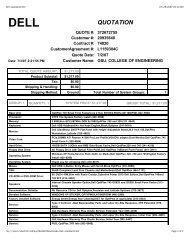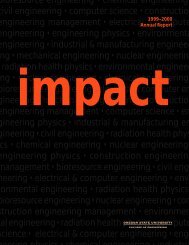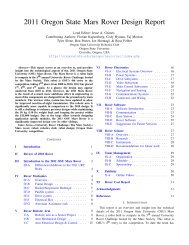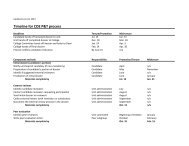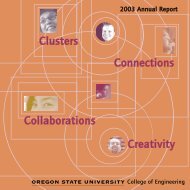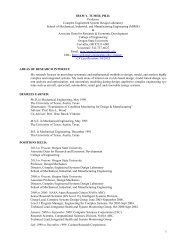Uncertainty of the iodine-131 ingestion dose conversion factor
Uncertainty of the iodine-131 ingestion dose conversion factor
Uncertainty of the iodine-131 ingestion dose conversion factor
Create successful ePaper yourself
Turn your PDF publications into a flip-book with our unique Google optimized e-Paper software.
1960’s, when fuel was cooled for longer periods before processing and when effective emissioncontrols were in place, various long-lived fission products began to dominate <strong>the</strong> annual <strong>dose</strong>estimates, but total <strong>dose</strong> was at least an order <strong>of</strong> magnitude lower and continued to decrease.Dose reconstruction efforts at DOE’s Hanford Site have shown that, for releases <strong>of</strong> <strong>131</strong> I, <strong>the</strong>consumption pathway accounts for more than 95% <strong>of</strong> total <strong>dose</strong> with milk consumption accountingfor 80% and beef, eggs, and fruit making up <strong>the</strong> additional 15% (11) . Uncertainties in <strong>the</strong> calculation<strong>of</strong> historical atmospheric concentrations <strong>of</strong> <strong>131</strong> I are on <strong>the</strong> order <strong>of</strong> a <strong>factor</strong> <strong>of</strong> 2 to 10 (12) , while <strong>the</strong>total reconstructed <strong>dose</strong> <strong>of</strong> <strong>131</strong> I is estimated to have a 90% confidence range <strong>of</strong> a <strong>factor</strong> <strong>of</strong> 15 for <strong>the</strong>maximum individual (2) . For a representative (average) individual at any given location, however,90% <strong>of</strong> <strong>the</strong> <strong>dose</strong> estimates are within a <strong>factor</strong> <strong>of</strong> 25 at Hanford (13) . Sensitivity analyses showed that<strong>the</strong> parameter to which <strong>the</strong> dosimetry models were consistently most sensitive was <strong>the</strong> <strong>iodine</strong> <strong>dose</strong><strong>conversion</strong> <strong>factor</strong> (DCF) (13) . This is not surprising since <strong>the</strong> DCF is very influential to <strong>dose</strong>estimates from all pathways, similar to that shown by Hamby (14) with <strong>the</strong> aggregated atmospherictritium model. Knowledge <strong>of</strong> <strong>the</strong> uncertainties related to <strong>the</strong> calculation <strong>of</strong> <strong>the</strong> <strong>131</strong> I <strong>ingestion</strong> DCF,<strong>the</strong>refore, will greatly improve our confidence in <strong>the</strong> <strong>dose</strong> reconstruction effort and <strong>the</strong> prediction <strong>of</strong><strong>the</strong> consequences related to radio<strong>iodine</strong> intake.METHODA probabilistic estimation <strong>of</strong> <strong>the</strong> <strong>131</strong> I adult <strong>ingestion</strong> <strong>dose</strong> <strong>conversion</strong> <strong>factor</strong> was generatedby multiple calculations <strong>of</strong> <strong>dose</strong> to <strong>the</strong> thyroid following a 1 Bq intake via <strong>ingestion</strong>. An Excel ®spreadsheet was written that contains modules for calculating <strong>the</strong> S-<strong>factor</strong>, <strong>the</strong> integrated activity in<strong>the</strong> thyroid, and <strong>the</strong> <strong>dose</strong> <strong>conversion</strong> <strong>factor</strong>. As an add-on to Excel, <strong>the</strong> Crystal Ball ® s<strong>of</strong>twarepackage was used to accumulate many iterations <strong>of</strong> <strong>the</strong> DCF calculation and to perform statisticalanalyses on input and output parameter values. The sections that follow present each <strong>of</strong> <strong>the</strong>calculational steps in more detail.2


